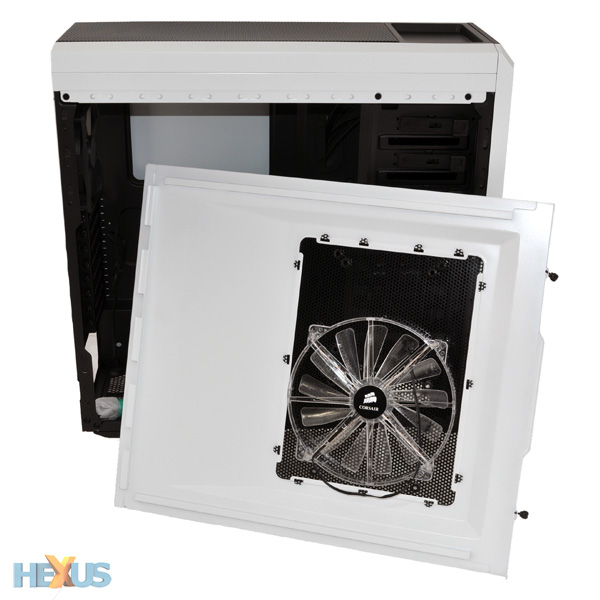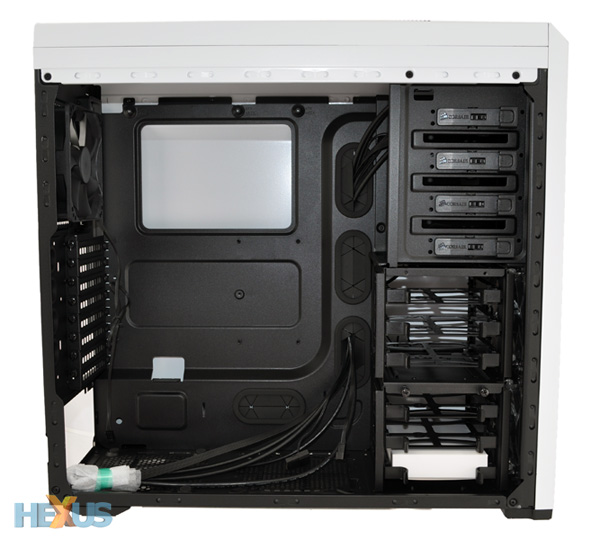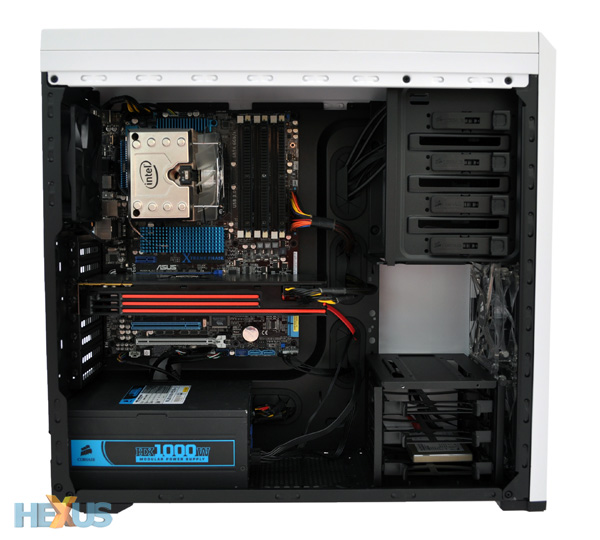Inside the Carbide Series 500R

The "outrageous cooling flexibility" that Corsair alludes to begins up top, where a spring-loaded mesh panel lifts up to reveal a pair of 120/140mm fan mounts. Both slots are unoccupied out the box, but this hidden area is of course a prime position for a 240mm liquid-cooling radiator such as Corsair's own Hydro H100.
There's enough room for a radiator to be installed in the top chamber, with a pair of fans attached inside the main cavern, but the chassis isn't designed to accommodate four fans in a push/pull configuration. If you're contemplating the latter, you'd be forced to lose the mesh cover and have two fans in clear view.

Up next on the cooling agenda is a 200mm side intake that comes pre-attached to a mesh insert in the left side panel. The fan's equipped with a white LED (as are the other intakes) and its three-pin connector hooks up to the integrated fan controller. The cabling is long enough for the side panel to be easily detached, but you'll need to remember to disconnect the fan before pulling the panel away completely.
The chassis itself supports up to 10 fans in total, but only four are included as standard. In addition to the 200mm side intake, there are two 120mm front intakes and a single 120mm rear exhaust. Like the 400R, there's room to expand with a further two 120mm fan mounts on the hard-disk cages, a 120/140mm slot for a bottom intake, and if you choose to do so, the 200mm side intake can be replaced with a pair of 120/140mm fans.

The addition of a 200mm side intake is arguably the 500R's most convincing argument against the 400R, but there's a subtle change inside that's also worth mentioning. The chassis' hard drive bays are now split across two cages that are both removable, allowing the user to create a clear airflow path from front to back.
These are all welcome changes, but the 500R interior is otherwise identical to the cheaper 400R. Though, that's by no means a criticism - as we found the 400R to be excellent to work with.
There's ample room within the internal cavity, and both the layout and cable management provisions help facilitate a very rewarding build process. All four 5.25in optical bays are tool free, all six storage bays support 2.5in or 3.5in drives, there's a pull-out dust filter beneath the bottom-mounted PSU bay, and the half-a-dozen cable-routing holes - four of which are rubber-grometted - are perfectly placed around the sunken motherboard tray. Thanks to the bulging side panels, there's also more than enough room behind the tray to store excess cabling well out of view.
The 500R is ultimately fantastic to work with, and building a high-end system into the enclosure takes no time at all. It's very much builder-friendly, but it isn't as feature packed as we'd hoped.
Take for example the integrated fan controller. It's a nice touch (and it helps keep noise in check), but it supports only three fans - despite the fact that the chassis is shipped with four. By default, the front two intakes and the side 200mm fan are all hooked up to the fan controller, but the rear 120mm exhaust isn't - so you'll need to take care of that one yourself.
The front I/O panel could arguably be better stocked, too. We like the fact that the two USB 3.0 ports connect directly to a supporting motherboard header, but two forward-facing USB ports isn't a lot, and the implementation of a FireWire jack is questionable on a gamer-orientated enclosure.

The feature list could certainly be expanded upon - we'd like to see more USB ports and the ability to convert the 5.25in bays to 3.5in bays - but what the 500R does, it does particularly well.
Maintaining a clean-looking build is easy, there's plenty of room for a couple of obscenely-long graphics cards (anywhere up to 452mm), and performance, as we're about to demonstrate, is very good.









